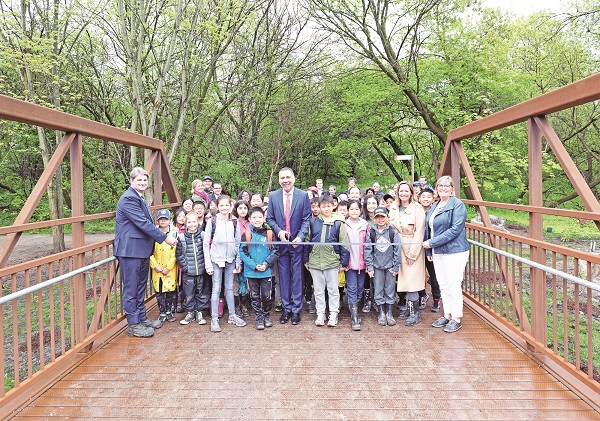General News » News
Removing remnants of century-old sawmill frees stream for local brook trout, uncovers history
June 5, 2019 · 0 Comments

By Brock Weir
For over a century, pieces of our forgotten history were concealed just underfoot at Sheppard’s Bush, but recent efforts to replace a century-old concrete bridge have helped Aurora uncover a piece of its heritage and improve the environment.
On Tuesday, Mayor Tom Mrakas was joined by members of the Lake Simcoe Conservation Authority and students from Aurora Grove Public School to help dedicate a new bridge along the tributary of the East Holland River that flows through the popular conservation area.
The new bridge, built to accommodate both foot and vehicular traffic, replaced a concrete span over a century old, the last remnants of a sawmill that played a part in the early settlement of Aurora.
“The structure was over 100 years old and the Town did a structural integrity evaluation where an engineer did a review and basically said it was not safe for any vehicles to travel over,” says Brook Piotrowski, Restoration Project Manager for the LSRCA. “Maintenance crews couldn’t go over it because of how bad a condition the concrete was. One of the big reasons for us at the Conservation Authority [to get involved] is this stream has brook trout and the existing structure was an obstruction for fish to migrate through that crossing. The water could get through but the fish could not. That was an issue for us as we need to remove as many barriers as possible to allow the brook trout and fish to migrate, spawn and do what they need to do.”
The bridge replacement was a partnership between the Town and the LSRCA, working with different funding partners, including the Department of Fisheries and Oceans.
The prior bridge was very tight and confined compared to today’s standards and during a high rain event, water would sometimes flow up on top and around the bridge.
The new bridge allows the tributary to meander and flow as nature intended, with nothing impeding its flow, allowing the fish to flourish.
The process to replace the bridge, however, yielded some unexpected results.
“We at the Authority took the lead on doing an overall analysis of the site,” says Mr. Piotrowski, noting they hired geomorphologists to analyse the site, making sure the creek didn’t need to be realigned and what kind of footings the soil would require to ensure the bridge would be stable and secure for vehicular and pedestrian traffic.
“We found that in the 1900s, there was a dam further built upstream and downstream of that dam, the current location where the bridge is now, was a sawmill,” he says. “They kind of funneled the waters through this one concrete opening for the water to go through quickly, and that velocity or increase in speed gave the power for a mill to spin the water wheel which then attached to saw blades. That was done in the early 1900s. Given that amount of time, seeing ice, frost and tree roots going through it, the concrete structure was in really, really bad shape.
“The neat thing about this project is through that cultural report, we recognized some of the historic value to this. Working with the contractor to remove that structure and put more of an open span bridge, we actually carefully dismantled the old structure and saved a lot of the pieces that still had some history to it. What’s cool is there are saw blades that were poured in the wet concrete that are protruding out. New concrete today, to make it stronger, they put reinforcement bar in it. Back in the day they didn’t have that, so they used whatever they could find. In this case, the dull saw blades that were no longer good for cutting wood, they actually put that in the concrete. Those saw blades have been sitting in the concrete at this crossing for over 100 year.”
The Town, he says, is currently working on signage to be placed near some of the salvaged concrete to explain the history of the site.
The reconstructed bridge was dedicated last Tuesday afternoon, May 28, the culmination of a day’s worth of activities on site, which included the planting of more than 200 native species of trees and shrubs around the bridge site by Aurora Grove Public School students, who braved the rain to leave their mark on a hidden part of Aurora that now blends the old with the new.











